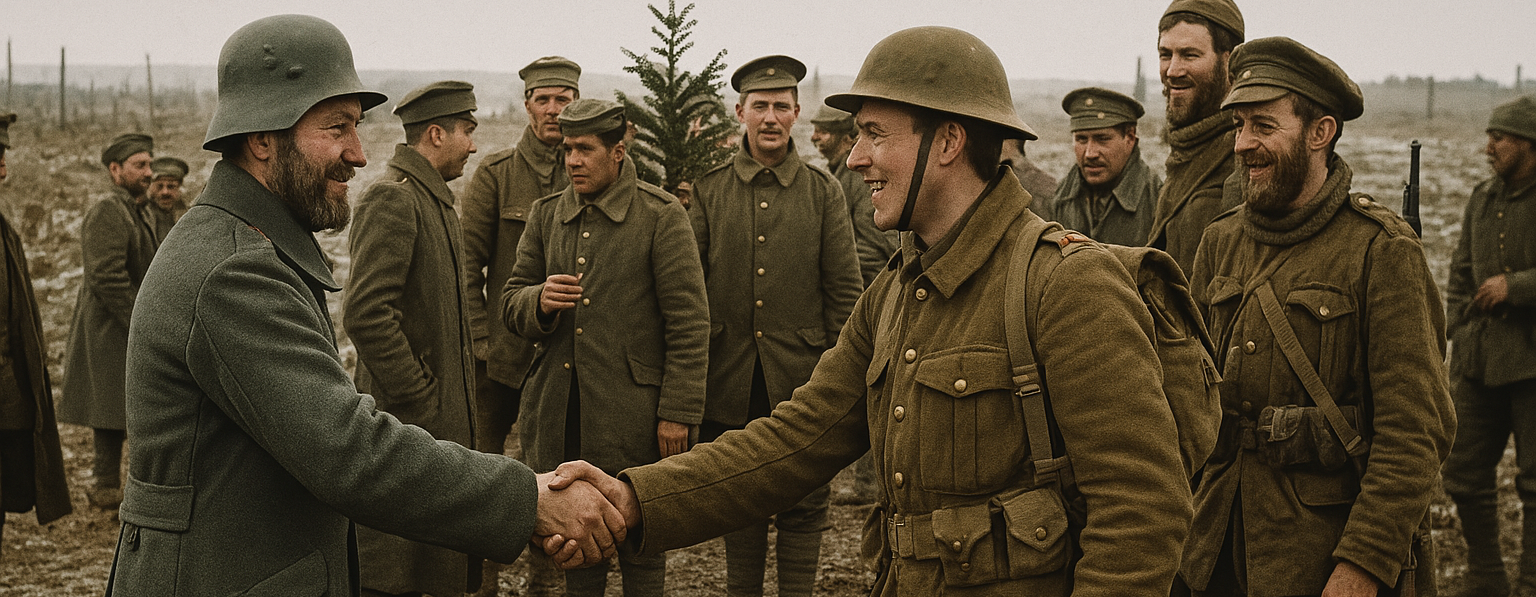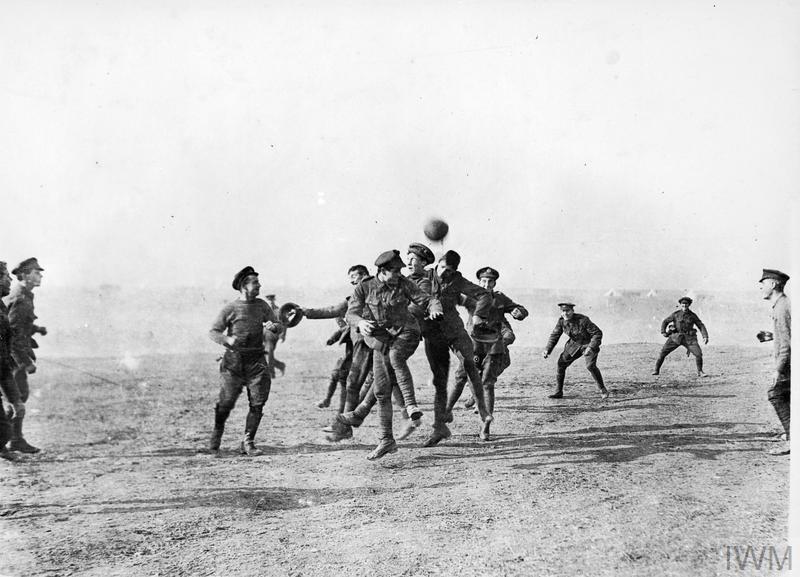The 1914 Christmas Truce was an unofficial series of ceasefires on the Western Front during which enemy soldiers, on their own initiative, laid down their arms, met peacefully, exchanged gifts, and played football. The 1914 Christmas Truce is one of the interesting events of the First World War. On the Western Front, these unofficial ceasefires, which took place in late December 1914, resulted in soldiers from opposing armies—primarily British, French, and German—laying down their arms, meeting, exchanging goods, and even playing impromptu football matches in some areas. The Christmas Truce was not a single event, but a mosaic of temporary moments that occurred at the local level. These moments were shaped by the spirit of the Christmas season and a shared human experience in the harsh conditions of war.
Historical Context
The First Months of World War I
World War I, which began in the summer of 1914, plunged Europe into a large-scale conflict. In August, Germany invaded Belgium and advanced towards France. The British Expeditionary Force (BEF) was sent to the continent to support the Allied forces. In this process, mobile conflicts were quickly replaced by trench warfare. Along the Western Front, stretching from Belgium to Northern France, trench lines left soldiers facing challenging environmental conditions.
The Battles of the Marne and First Ypres, which took place in September and October, led to the stabilization of the front line. In the early months of the war, soldiers began to live in trenches where basic necessities were scarce. As winter conditions worsened, living conditions on the front deteriorated, negatively impacting morale. The conflict, which was initially expected to end quickly, lasted longer than anticipated, changing war expectations for both sides.
The Cultural Significance of Christmas
By 1914, Christmas held a significant cultural and religious place in European societies. This period, with its themes of peace and goodwill, was observed to hold a common meaning among soldiers on the front. Soldiers on both sides reflected in various ways the emotional void created by spending this period away from their families in a conflict environment. In German trenches, traditional elements such as Christmas trees and candles were present, and this situation influenced the shaping of the process.
The limited propaganda activities and dehumanizing language during this period is also striking. Many soldiers on the front perceived their counterparts on the other side not as direct individuals on a personal level, but as counterparts in similar circumstances. This mutual perception was an influential factor in the emergence of the truce.
The Development of the Truce
First Contacts
By 1914, Christmas held a significant cultural and religious place in European societies. This period, with its themes of peace and goodwill, was observed to hold a common meaning among soldiers on the front. Soldiers on both sides reflected in various ways the emotional void created by spending this period away from their families in a conflict environment. In German trenches, traditional elements such as Christmas trees and candles were present, and this situation influenced the shaping of the process.
The limited propaganda activities and dehumanizing language during this period is also noteworthy. Many soldiers on the front perceived their counterparts on the other side not as direct individuals on a personal level, but as counterparts in similar circumstances. This mutual perception was an influential factor in the emergence of the truce.
Meeting in No Man’s Land
On the morning of December 25, the most prominent moments of the truce occurred. No Man’s Land, normally a conflict zone, became a temporary meeting place. Soldiers emerging from their trenches approached each other with a certain caution. These contacts quickly developed into mutual interactions. The exchange of cigarettes and small gifts was an important part of this process. In some areas, German soldiers are reported to have offered beer and sausages, while the British gave whiskey and canned food.

Stuck German and British Soldiers (Created with Artificial Intelligence)
Many primary sources exist about these moments. For example, a letter from Captain Robert Hamilton of the British 2nd Division describes a friendly meeting with a German officer. Similarly, a soldier from the German 16th Infantry Regiment noted in his diary an exchange of souvenirs with British troops. These documents are important in documenting the local and human aspects of the events.
Football Matches
One of the most well-known aspects of the Christmas Truce is the alleged football matches played in No Man’s Land. However, the scale and nature of these matches are debated among historians. Some primary sources, particularly letters from British soldiers, mention impromptu matches. For example, a soldier from the Royal Warwickshire Regiment wrote, “We played football with the Germans, and we beat them 3-2.” However, most of these matches were informal events where a few soldiers kicked a tin can or makeshift ball, rather than an organized game.
Stories of football have played a significant role in romanticizing the truce, but there have been instances of exaggeration. While there are no official match records, soldiers’ letters and oral accounts confirm that such events took place in at least some areas.

A Football Match During the Christmas Truce (IWM)
Scope and Limits of the Truce
Geographical Distribution
The truce was concentrated in specific areas, not across the entire Western Front. The areas around Ypres in Belgium and Artois in France, where British and German troops faced each other, were the most documented truce areas. A limited number of fraternization incidents were also reported between French and German troops, but French soldiers were generally more distant due to the occupation of their territory.
In some areas, the truce lasted only a few hours; in others, it extended to several days. For example, in a sector where the British 1st Division was located, the truce continued until December 26, and both sides made a joint effort to bury the dead soldiers.
The Chain of Command’s Response
The truce was initiated by the soldiers themselves and was not approved by senior commanders. From a military discipline standpoint, such fraternization was considered a serious violation. Both the British and German armies took strong measures upon news of the truce. The British High Command issued an order on December 26 prohibiting similar incidents from being repeated. On the German side, some officers are known to have warned soldiers and even imposed disciplinary punishments.
Despite this, most junior officers on the ground during the truce turned a blind eye to the event in order not to damage the morale of the soldiers.
Cultural and Social Impacts
Contemporary Perceptions
The Christmas Truce had a wide impact both on the front and behind the lines during the war.
Soldiers’ letters and diaries conveyed these events to their families and friends. In Britain, newspapers such as "The Times" and "Daily Mail" published letters from soldiers, sharing the story of the truce with the public. However, these reports were often censored and used for propaganda purposes.
In Germany, news of the truce was less common, as military censorship was stricter. Nevertheless, some local newspapers featured stories told by soldiers. On both sides, the truce temporarily boosted public morale by revealing the human face of war.
Propaganda and Mythology
As the war progressed, the narrative of the Christmas Truce was shaped by propaganda and mythology. On the British side, the truce was romanticized with an emphasis on camaraderie, peace, and humanity. On the German side, although less emphasized, some narratives highlighted the disciplined yet humane aspects of German soldiers.
Stories such as football matches were exaggerated, particularly in the late 20th century in popular culture, becoming a legend. Films, novels, and documentaries emphasized the emotional aspects of the truce, sometimes overshadowing its historical complexities.
Historical Legacy
Remembering the Truce
The Christmas Truce was remembered as a symbol of peace and humanity in the 20th and 21st centuries. In 2014, the 100th anniversary of the truce was celebrated with various events across Europe. In Britain, memorials were erected and exhibitions were held to commemorate the football matches played in No Man’s Land. UEFA organized a commemorative match near Ypres.
The truce also became a powerful symbol for anti-war movements. Peace groups argued that the truce showed that people could come together even under the most difficult circumstances.
Its Place in Modern Culture
In popular culture, the Christmas Truce has inspired many works. The 2005 film "Joyeux Noël" explored the emotional and dramatic aspects of the truce. Similarly, Paul McCartney’s song “Pipes of Peace” and Sainsbury’s 2014 advertising campaign brought the spirit of the truce to a wide audience.
The truce has also been a frequently explored theme in literature. Works such as Michael Morpurgo’s "War Horse" conveyed the humane message of the truce to younger generations. However, these works sometimes prioritized emotional impact over historical accuracy.


